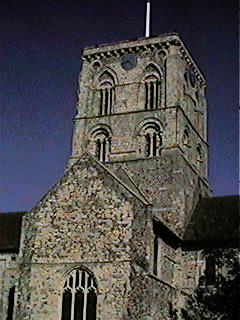 Died about 1180. Died about 1180.
William de Braose, 3rd lord of Bramber was a Marcher lord, active during the 12th century period of anarchy and the subsequent reign of Henry II. He served as sheriff of Herefordshire from 1173 to 1175.
William was the eldest son of Philip de Braose, lord of Bramber. His mother was Aenor, daughter of Juhel of Totnes. He was the third in the line of the Anglo-Norman Braose family. After his father died in the 1130s William held lordships, land and castles in Sussex, with his caput at Bramber, also at Totnes in Devon and Radnor and Builth in the Welsh Marches. He confirmed the grants of his father and grandfather to the abbey of St Florent in Anjou and made further grants to the abbey's dependent priory at Sele in Sussex. About 1155, he also inherited through his mother's family one half of the honour of Barnstaple in Devon, paying a fee of 1000 marks for the privilege.
William became an internationally recognised figure. When Archbishop Theobald of Canterbury was asked by Pope Adrian IV to inquire into the background of a certain Walter, canon of St Ruf, his reply, dated to 1154/9 read:
"The facts which you demand need but little enquiry; for they shine so brightly in themselves that they cannot be hid; so great is the brilliance of his noble birth and the glory of all his kin. For Walter, as we know for a fact, was the son of a distinguished knight and born of a noble mother in lawful wedlock, and he is closely related by blood to the noble William de Braose."
William had married Bertha, daughter of Miles of Gloucester by 1150. When each of Bertha's four brothers died leaving no issue William's marriage became unexpectedly valuable. He gained control of the lordships of Brecon and Abergavenny after 1166 when the last brother died. These additional land holdings greatly expanded the territorial power and income of the Braose family. They now held a vast block of territory in the Middle March as well as their extensive interests in Sussex and Devon. William's daughters were able to make good marriages, notably Sibyl to William de Ferrers, Earl of Derby. William's son and heir, became a major player in national politics under King John.
Empress Maud landed in England in 1139 in an attempt to press her claim to the monarchy. She was soon besieged by King Stephen's forces at Arundel castle. Stephen allowed Maud a safe conduct to Bristol, and provided her with an escort which included William de Braose. Thus, at the start of this conflict, William was an adherent of King Stephen. He witnessed three charters with Stephen at Lewes dated by Davis as 1148/53 so it appears that he remained loyal to the king until the Treaty of Wallingford which ended the hostilities.
William was in Sussex in 1153, but he followed Duke Henry, soon to become King Henry II, across to Normandy in 1154. William was frequently with the new king. He was one of the great men in the army at Rhuddlan in 1157. He witnessed one of the king's charters at Romsey in 1158 and he is recorded at the king's court in Wiltshire in 1164 when the Constitutions of Clarendon were enacted. He accompanied the king on expedition to France, witnessing at Leons, in 1161 and Chinon in 1162. William is also documented on the Irish campaign at Dublin in 1171 and Wexford 1172.
When Henry was facing war with his sons in 1173, William was appointed as sheriff of Hereford at Easter. He maintained the King's interests in Herefordshire until 1175. King Henry withdrew his favour from the family after William's son organised the murder of Seisyll ap Dyfnwal and other Welsh princes at Abergavenny in 1175. There is little record of William in public life after this and it is likely that he retired to his estates in Sussex. It is at this time that the extensions were made to St. Mary's, Shoreham. (Pictured at top)
(The above is an adaptation of the article I wrote for Wikipedia. Sources for the information given can be found there.)
Father: Philip de Braose
Mother: Aanor
Married to Bertha, daughter of Miles of Gloucester, Earl of Hereford
Child 1: William de Braose, 4th Lord of Bramber
Child 2: Maud = John de Brompton
Child 3: Sibilla = (1)William de Ferrers =(2)Adam de Port
Child 4: John
Child 5: Roger
Roger is a witness to a charter of his brother William. (Dugdales "Monasticon" iv, p616)
Child 6: Philip
(Some sources give this William a daughter Bertha who married a Beauchamp. I believe this Bertha is a daughter of William de Braose, 4th Lord of Bramber. See her page for references.) |
